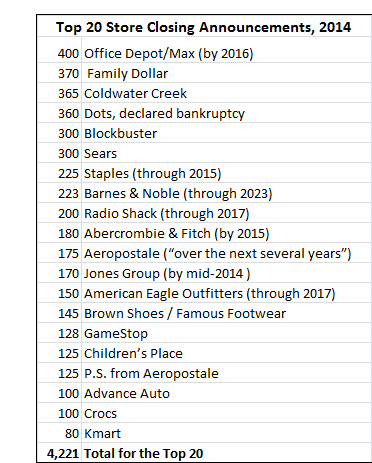Today, we take a business trip!
The retail sector of the US economy is not doing so well. The Census Bureau tracks retail sales in the US, and sales decreased 0.30% in September, compared to the previous month. Retail Sales month over month in the US gained an average of 0.37% from 1992 until 2014, reaching an all-time high of 6.71% in October of 2001.
This week, NCR, the maker of point-of-sale devices for the retail industry who call themselves “the global leader in consumer transaction technologies”, announced disappointing third quarter results. NCR blamed particularly the “challenging retail market” for its debacle. CEO Bill Nuti explained it this way:
Market conditions within the retail industry worsened in the third quarter, as evidenced by weak same store sales comparisons and financial results. This resulted in our retail customers spending more cautiously than anticipated and further delaying solution roll-outs…Additionally, ongoing retail consolidation continues to be a factor impacting our performance.
NCR has noticed that brick-and-mortar retailers are cutting back. “Ongoing retail consolidation,” Nuti called it. And some, like Radio Shack, are likely to use bankruptcy courts to do it. The structural problems in the brick-and-mortar retail industry include Sears, which is closing 300 Sears stores and 80 Kmart stores.
Some of us wonder why anyone still buys there. Retail chains, large and small, have announced an epidemic of store closings in 2014. Here are the “Top 20? announcements of store closings. For these 20 chains, the total number of stores to be closed exceeds 4,200. The number of closed stores is the first column:
 Store closings add up: Jobs are lost, consumer spending weakens, and fewer tax revenues are paid to states and the federal government. This process has been going on for years. As a side note: when all this washes out, who is going to fill the vacant retail space in our malls? That’s one of the many secondary effects of the troubles in the American retail industry.
Store closings add up: Jobs are lost, consumer spending weakens, and fewer tax revenues are paid to states and the federal government. This process has been going on for years. As a side note: when all this washes out, who is going to fill the vacant retail space in our malls? That’s one of the many secondary effects of the troubles in the American retail industry.
Hopefully, you haven’t invested in those Shopping Center Trusts.
Source: Wolf Richter
Yet, some box store retail continues to grow. Starbucks is opening another 1400 stores in the US by 2017, a 13% growth rate. They prove there is a market for things that can’t be ordered and delivered hot over the Internet. But, the openings of new retail locations for 2014 will not offset the closures. Much of domestic retail expansion in 2014 is about discount stores. Between Dollar General, Family Dollar and Dollar Tree, more than 1400 new discount stores will be opening, using the original Walmart expansion strategy. At the same time, Walmart is abandoning its own strategy. The New York Times reports that: (brackets by the Wrongologist)
Walmart’s woes [are causing] a change in corporate strategy. Walmart will slow store openings in the United States next year, opening 60 to 70 supercenters, compared with 120 this year…The Company is shifting its focus toward smaller Neighborhood Market grocery stores, and it said it would open 180 to 200 of them next year. It is also accelerating its online offerings…
Auto sales (mostly at retail box stores) have been booming, Reuters reports that: (brackets by the Wrongologist)
The annualized sales rate slowed to 16.4 million [units]…above last year’s 15.4 million, but well below the 17.5 million [annualized] pace in August.
This performance was partly due to cheap money, long financing terms, and a focus on subprime customers. Jim Lentz, US chief executive at Toyota Motor Corp:
We are seeing more ‘subprime,’ which is good.
In one report, a 71 year old Queens NY woman on food stamps got a $16,000 loan on a used car:
After two test drives and about two hours, the dealership found her a loan: $16,000 financing for a used 2014 Ford Fiesta. There would be a bank fee of about $4,000, and she would have an interest rate of 20.23%
Subprime, indeed. As for the role of consumer spending in our economy, American consumers are stressed. Many have had to curtail their spending, or make up the difference with borrowed money. Closing retail stores may be the canary in a coal mine for our consumer economy. For some business owners, considering some retail store analytics might provide insight into how to keep their stores open.
The best measure of economic security is ownership of wealth. Yet, using Median Wealth as a yardstick, the middle class in the US ranks only 27th in the world. Here is how we rank against two of our allies:
#27 USA: $44,911 ? hardly enough to pay for an operation in a US hospital
#1 Australia: $219205
#6 United Kingdom: $111,524
Global wealth has reached a new all-time high of $241 trillion, up 4.9% since last year and 68% since 2003, with the USA accounting for 72% of the latest increase.
Perhaps the solution in the US is to not to tax based only on income, but to tax based on income and assets. If you own or control 80 to 90% of the assets of this country, and the country’s resources are securing, maintaining, and protecting your assets, it stands to reason that you should also be bearing the majority of the tax burden of the country.
